Samsung T9 Portable SSD Review: A 20 Gbps PSSD for Prosumer Workloads
by Ganesh T S on October 3, 2023 10:00 AM EST- Posted in
- Storage
- SSDs
- Samsung
- External SSDs
- USB 3.2 Gen 2x2
- Portable SSDs
Performance Benchmarks
Benchmarks such as ATTO and CrystalDiskMark help provide a quick look at the performance of the direct-attached storage device. The results translate to the instantaneous performance numbers that consumers can expect for specific workloads, but do not account for changes in behavior when the unit is subject to long-term conditioning and/or thermal throttling. Yet another use of these synthetic benchmarks is the ability to gather information regarding support for specific storage device features that affect performance.
Samsung claims speeds of up to 2000 MBps for the T9 4TB version. Our ATTO testing configuration manages to reach numbers quite close to the advertised one for reads, while the writes are a bit lower. However, we only use a single queue depth of 4 - so, it is only representative of a small subset of real-world workloads. It does allow the visualization of change in transfer rates as the I/O size changes, with optimal performance being reached around 1 MB for a queue depth of 4.
| ATTO Benchmarks | |
| TOP: | BOTTOM: |
 |
|
 |
|
CrystalDiskMark uses four different access traces for reads and writes over a configurable region size. Two of the traces are sequential accesses, while two are 4K random accesses. Internally, CrystalDiskMark uses the Microsoft DiskSpd storage testing tool. The 'Seq128K Q32T1' sequential traces use 128K block size with a queue depth of 32 from a single thread, while the '4K Q32T16' one does random 4K accesses with the same queue configuration, but from multiple threads. The 'Seq1M' traces use a 1MiB block size. The plain 'Rnd4K' one uses only a single queue and single thread . Comparing the '4K Q32T16' and '4K Q1T1' numbers can quickly tell us whether the storage device supports NCQ (native command queuing) / UASP (USB-attached SCSI protocol). If the numbers for the two access traces are in the same ballpark, NCQ / UASP is not supported. This assumes that the host port / drivers on the PC support UASP.
| CrystalDiskMark Benchmarks | |
| TOP: | BOTTOM: |
 |
|
 |
|
The writes fall short of Samsung's claims, but the PSSD is indeed able to reach 2000 MBps for large-sized reads. Both NCQ and UASP are supported. Since the base platform is a DRAM-less NVMe SSD, the random access numbers are not as good as what can be obtained with a DRAM-equipped PSSD such as the SanDisk Extreme PRO v2.
AnandTech DAS Suite - Benchmarking for Performance Consistency
Our testing methodology for storage bridges / direct-attached storage units takes into consideration the usual use-case for such devices. The most common usage scenario is transfer of large amounts of photos and videos to and from the unit. Other usage scenarios include the use of the unit as a download or install location for games and importing files directly from it into a multimedia editing program such as Adobe Photoshop. Some users may even opt to boot an OS off an external storage device.
The AnandTech DAS Suite tackles the first use-case. The evaluation involves processing five different workloads:
- AV: Multimedia content with audio and video files totaling 24.03 GB over 1263 files in 109 sub-folders
- Home: Photos and document files totaling 18.86 GB over 7627 files in 382 sub-folders
- BR: Blu-ray folder structure totaling 23.09 GB over 111 files in 10 sub-folders
- ISOs: OS installation files (ISOs) totaling 28.61 GB over 4 files in one folder
- Disk-to-Disk: Addition of 223.32 GB spread over 171 files in 29 sub-folders to the above four workloads (total of 317.91 GB over 9176 files in 535 sub-folders)
Except for the 'Disk-to-Disk' workload, each data set is first placed in a 29GB RAM drive, and a robocopy command is issue to transfer it to the external storage unit (formatted in exFAT for flash-based units, and NTFS for HDD-based units).
robocopy /NP /MIR /NFL /J /NDL /MT:32 $SRC_PATH $DEST_PATH
Upon completion of the transfer (write test), the contents from the unit are read back into the RAM drive (read test) after a 10 second idling interval. This process is repeated three times for each workload. Read and write speeds, as well as the time taken to complete each pass are recorded. Whenever possible, the temperature of the external storage device is recorded during the idling intervals. Bandwidth for each data set is computed as the average of all three passes.
The 'Disk-to-Disk' workload involves a similar process, but with one iteration only. The data is copied to the external unit from the CPU-attached NVMe drive, and then copied back to the internal drive. It does include more amount of continuous data transfer in a single direction, as data that doesn't fit in the RAM drive is also part of the workload set.
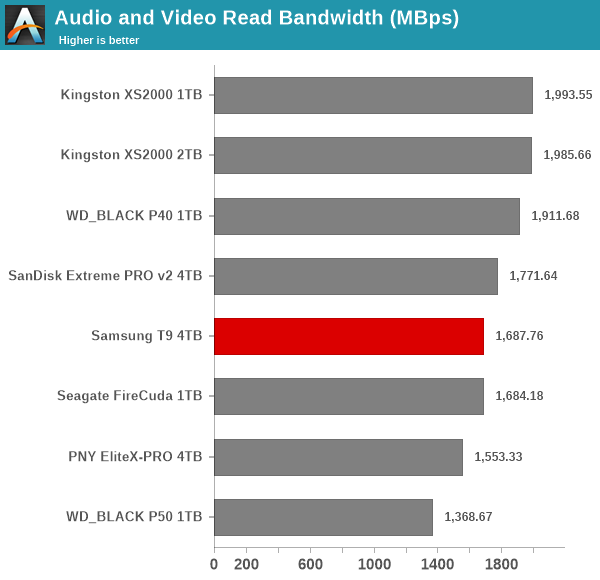
The Samsung T9 marks its entry in the middle or lower half of the pack in all of the cases above. There are two contributing factors here - PSSDs with DRAM perform inherently better when bombarded with accesses, and the direct-to-TLC write speeds for the 6th Gen. V-NAND used in the T9 are probably not as good as those for the other NAND used in other PSSDs in the above graphs.
Performance Consistency
Aspects influencing the performance consistency include SLC caching and thermal throttling / firmware caps on access rates to avoid overheating. This is important for power users, as the last thing that they want to see when copying over 100s of GB of data is the transfer rate going down to USB 2.0 speeds.
In addition to tracking the instantaneous read and write speeds of the DAS when processing the AnandTech DAS Suite, the temperature of the drive was also recorded. In earlier reviews, we used to track the temperature all through. However, we have observed that SMART read-outs for the temperature in NVMe SSDs using USB 3.2 Gen 2 bridge chips end up negatively affecting the actual transfer rates. To avoid this problem, we have restricted ourselves to recording the temperature only during the idling intervals. The graphs below present the recorded data.
| AnandTech DAS Suite - Performance Consistency | |
| TOP: | BOTTOM: |
 |
|
 |
|
The first three sets of writes and reads correspond to the AV suite. A small gap (for the transfer of the video suite from the internal SSD to the RAM drive) is followed by three sets for the Home suite. Another small RAM-drive transfer gap is followed by three sets for the Blu-ray folder. This is followed up with the large-sized ISO files set. Finally, we have the single disk-to-disk transfer set.
The T9 has very good performance consistency, with the SLC cliff barely seen in the RAM drive transfer sets. However, there is a sharp drop down to 900 MBps from 1.5 GBps in the disk-to-disk transfer set. That said, the temperature profile of the PSSD is very good, with the internals at 50C at the end of the transfer routine.
PCMark 10 Storage Bench - Real-World Access Traces
There are a number of storage benchmarks that can subject a device to artificial access traces by varying the mix of reads and writes, the access block sizes, and the queue depth / number of outstanding data requests. We saw results from two popular ones - ATTO, and CrystalDiskMark - in a previous section. More serious benchmarks, however, actually replicate access traces from real-world workloads to determine the suitability of a particular device for a particular workload. Real-world access traces may be used for simulating the behavior of computing activities that are limited by storage performance. Examples include booting an operating system or loading a particular game from the disk.
PCMark 10's storage bench (introduced in v2.1.2153) includes four storage benchmarks that use relevant real-world traces from popular applications and common tasks to fully test the performance of the latest modern drives:
- The Full System Drive Benchmark uses a wide-ranging set of real-world traces from popular applications and common tasks to fully test the performance of the fastest modern drives. It involves a total of 204 GB of write traffic.
- The Quick System Drive Benchmark is a shorter test with a smaller set of less demanding real-world traces. It subjects the device to 23 GB of writes.
- The Data Drive Benchmark is designed to test drives that are used for storing files rather than applications. These typically include NAS drives, USB sticks, memory cards, and other external storage devices. The device is subjected to 15 GB of writes.
- The Drive Performance Consistency Test is a long-running and extremely demanding test with a heavy, continuous load for expert users. In-depth reporting shows how the performance of the drive varies under different conditions. This writes more than 23 TB of data to the drive.
Despite the data drive benchmark appearing most suitable for testing direct-attached storage, we opt to run the full system drive benchmark as part of our evaluation flow. Many of us use portable flash drives as boot drives and storage for Steam games. These types of use-cases are addressed only in the full system drive benchmark.
The Full System Drive Benchmark comprises of 23 different traces. For the purpose of presenting results, we classify them under five different categories:
- Boot: Replay of storage access trace recorded while booting Windows 10
- Creative: Replay of storage access traces recorded during the start up and usage of Adobe applications such as Acrobat, After Effects, Illustrator, Premiere Pro, Lightroom, and Photoshop.
- Office: Replay of storage access traces recorded during the usage of Microsoft Office applications such as Excel and Powerpoint.
- Gaming: Replay of storage access traces recorded during the start up of games such as Battlefield V, Call of Duty Black Ops 4, and Overwatch.
- File Transfers: Replay of storage access traces (Write-Only, Read-Write, and Read-Only) recorded during the transfer of data such as ISOs and photographs.
PCMark 10 also generates an overall score, bandwidth, and average latency number for quick comparison of different drives. The sub-sections in the rest of the page reference the access traces specified in the PCMark 10 Technical Guide.
Booting Windows 10
The read-write bandwidth recorded for each drive in the boo access trace is presented below.

The mixture of access traces triggered by this workload is well serviced by dedicated NVMe SSD controllers - so we see the PSSDs based on native flash controllers in the lower half. The T9 makes a respectable entry by being better than the P50 from 2020. However, it is left way behind by the PSSDs using DRAM-equipped NVMe drives.
Creative Workloads
The read-write bandwidth recorded for each drive in the sacr, saft, sill, spre, slig, sps, aft, exc, ill, ind, psh, and psl access traces are presented below.
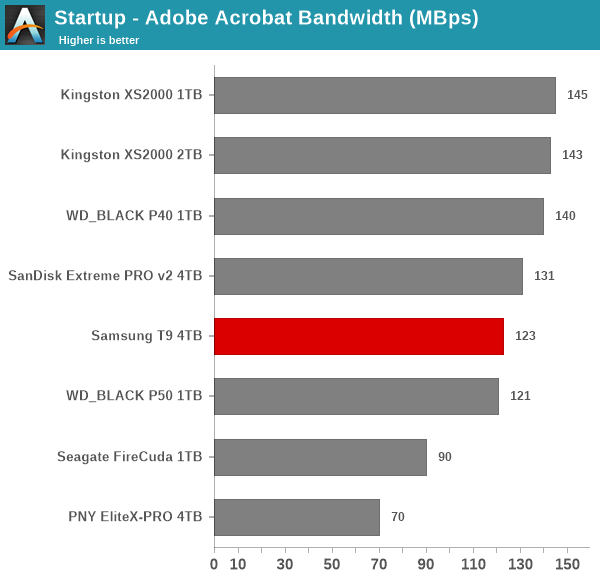
The T9 does not deliver exceptional performance for any of these workloads, but at the same time, it manages to place itself in the middle of the pack.
Office Workloads
The read-write bandwidth recorded for each drive in the exc and pow access traces are presented below.
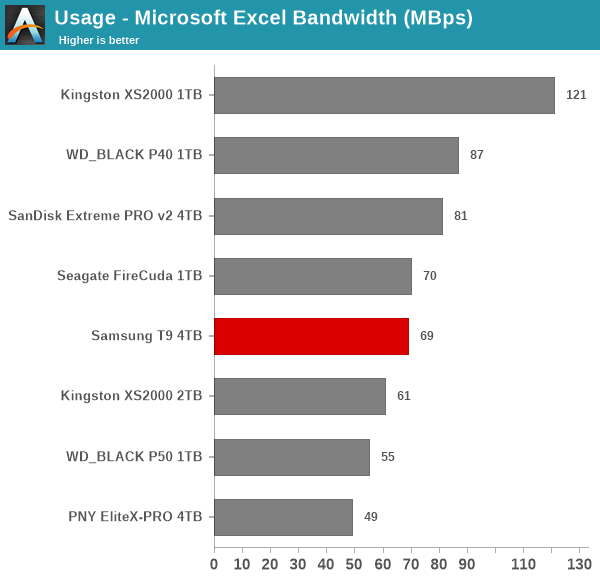
The presence of a Phison U17 drive in the comparison list helps save the T9 from making up the rear of the pack. The Powerpoint workload, in particular, is handled quite poorly by the T9.
Gaming Workloads
The read-write bandwidth recorded for each drive in the bf, cod, and ow access traces are presented below.
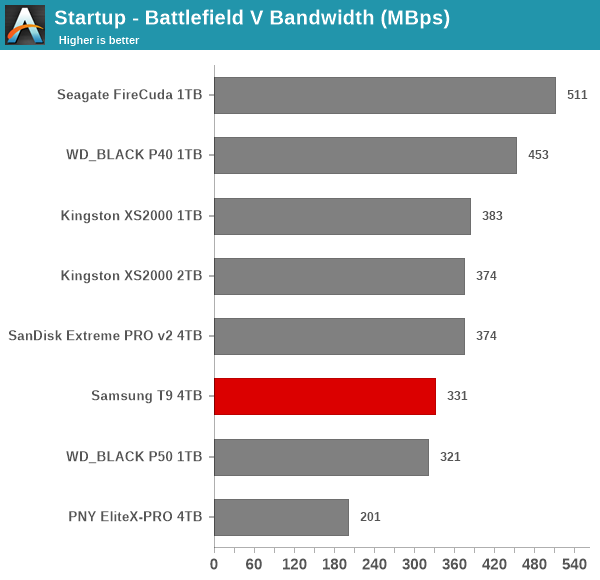
The scenario seen for the Office workloads plays out here also, with only the PNY EliteX-PRO faring worse for these read-intensive use-cases.
Files Transfer Workloads
The read-write bandwidth recorded for each drive in the cp1, cp2, cp3, cps1, cps2, and cps3 access traces are presented below.

The T9 performs moderately well here, and the presence of reads in the midst of write pressure exposes the shortcomings in the native flash controller-based PSSDs. Still, the T9 is not able to surpass the performance of DRAM-equipped drives.
Overall Scores
PCMark 10 reports an overall score based on the observed bandwidth and access times for the full workload set. The score, bandwidth, and average access latency for each of the drives are presented below.
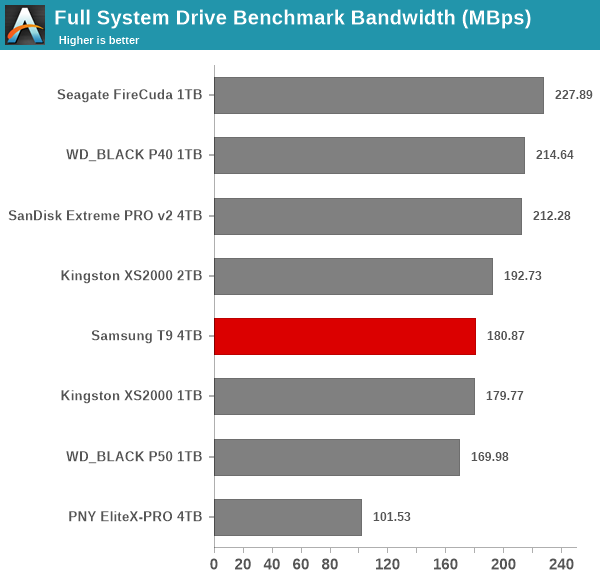
The T9 finds itself in the bottom half of the pack, but the absolute scores for all PSSDs without DRAM are fairly close to each other.










14 Comments
View All Comments
James5mith - Tuesday, October 3, 2023 - link
Sorry, but when do these launch? Currently no product listings except for a few sites with preorder links.Ryan Smith - Tuesday, October 3, 2023 - link
Technically it's available worldwide today. But at least in the US, you are correct. No one seems to be set to ship it before the 16th.HaninAT - Tuesday, October 3, 2023 - link
Samsung.com seems to have it and it claims to be shipping on Oct 6.https://www.samsung.com/us/computing/memory-storag...
jhoff80 - Tuesday, October 3, 2023 - link
This feels like a major cop-out in the conclusion to just recommend another drive which is known to have recent issues and then to just take the vendor's word for it that it's better now."we believe Western Digital has already addressed the problem if they are confident enough to continue selling it".
ganeshts - Tuesday, October 3, 2023 - link
A 'cop-out' would have been to not make any mention of the SanDisk external SSD problems at all while recommending it.To be frank, we have put two different 4TB SanDisk Extreme PRO v2 samples through our test suite - both were from the initial batches. One was with a firmware version that had a bug when hardware encryption was enabled - that never made it to a public release. For normal benchmarking without password protection, both drives had excellent performance and thermal profiles - as shown in the results.
If you just take a look at the different metrics, the SanDisk Extreme PRO v2 comes up short against the T9 in two aspects:
(1) pseudo-SLC cache size : 60 GB for the SD EP v2, vs. 175 GB for the T9, but if you look at the graph for the sequential write performance consistency test, writing 3.6 TB continuously to the SD EP v2 takes around 2150s, while it takes around 3700s. So, one can't say the T9 is a clear winner here.
(2) Higher power consumption - peak of 7.2W vs. 6.7W, but I will give it to the T9 here - the use of a single PCB and a DRAM-less solution is indeed more power efficient even on an average power consumption basis. The SD EP v2 uses a real M.2 NVMe SSD with DRAM for FTL in a separate board, and it does have a penalty from the energy consumption viewpoint.
I hold no torch for either WD (SanDisk) or Samsung here. I can only present analysis based on experimental results here. Unless I am going to be using the drive mainly with battery powered systems, the SD EP v2 is a better choice even from the cost perspective.
Modern-day SSDs are complex systems, and even the best vendors have had trouble with the products in this domain. Unless one goes for enterprise-focused products (that have longer validation cycles, better components, and correspondingly higher cost), there is always a risk (Even Samsung has had issues with some of their recent internal SSDs, prompting a well-known computer system assembler to drop some of those capacity points from their builds).
From a consumer viewpoint, it is always useful to follow the 3-2-1 rule. 3 copies of data in 2 different media, with at least 1 copy off-site. If you are backing up data in the field (from photo or video shoots), never delete the original contents from the card until the photos / videos have at least two other copies.
Aspernari - Friday, October 20, 2023 - link
Two whole samples! WOW. Good due diligence.> I can only present analysis based on experimental results here.
Incorrect. False. Wrong. Not true. A lie.
But you're a big part of why Anandtech has gone to hell over time, so... Keep it up?
Knowingly recommending products with known production issues is... Well. I guess that's the way stuff works here. Sort of like how Ian Cutress built this entire database of CPU performance benchmarks, in an un-airconditioned room in his home without controlling for (or measuring) ambient or CPU temperature, and just ran with it.
Or. Or. Or.
Why the hell do I keep coming back to this wasteland of a website?
Aspernari - Friday, October 20, 2023 - link
If you wanted to not cop out, you would have at least linked to another article documenting the original problem, and/or sourced a statement from the vendor. Instead, you just went with blind faith in a vendor to do the right thing. As a tech (or any other sort of) journalist, you know that's not how things work. And you know your duty doesn't stop and end at what you believe to have happened.PeachNCream - Thursday, October 5, 2023 - link
Prosumer - Thank goodness we have desperate marketing departments mashing words together to help customers feel bettwr about spending disposable income on largely frivilous electronics purchases. Sadly it works on nerd buyers quite well.Aspernari - Friday, October 20, 2023 - link
Prosumer has been used in this way for... What, 20+ years now? Welcome to 2004 or so at least.Maltz - Saturday, November 4, 2023 - link
I remember the term being in fairly common use in the 90's, and after some Googling, it was apparently coined in 1980.